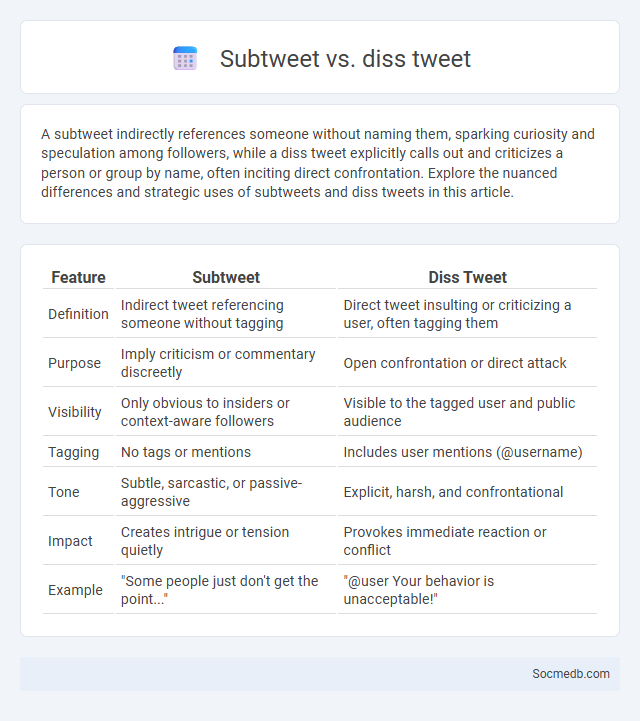
Photo illustration: Subtweet vs Diss Tweet
A subtweet indirectly references someone without naming them, sparking curiosity and speculation among followers, while a diss tweet explicitly calls out and criticizes a person or group by name, often inciting direct confrontation. Explore the nuanced differences and strategic uses of subtweets and diss tweets in this article.
Table of Comparison
| Feature | Subtweet | Diss Tweet |
|---|---|---|
| Definition | Indirect tweet referencing someone without tagging | Direct tweet insulting or criticizing a user, often tagging them |
| Purpose | Imply criticism or commentary discreetly | Open confrontation or direct attack |
| Visibility | Only obvious to insiders or context-aware followers | Visible to the tagged user and public audience |
| Tagging | No tags or mentions | Includes user mentions (@username) |
| Tone | Subtle, sarcastic, or passive-aggressive | Explicit, harsh, and confrontational |
| Impact | Creates intrigue or tension quietly | Provokes immediate reaction or conflict |
| Example | "Some people just don't get the point..." | "@user Your behavior is unacceptable!" |
Introduction to Subtweet, Diss Tweet, and Subtweet
Subtweeting is a social media practice where users post indirect messages targeting someone without mentioning them explicitly, often to express criticism or sarcasm. Diss tweets escalate this behavior by openly insulting or mocking others, increasing public drama on platforms like Twitter. Understanding subtweets and diss tweets helps decode online communication dynamics and the impact of digital interactions on personal relationships.
Understanding the Concept of Subtweet
A subtweet is a social media post that references or criticizes someone indirectly without mentioning their username, often used to express opinions or frustrations subtly. This tactic allows users to communicate private messages to select audiences while avoiding direct confrontation or notification to the subject. Understanding subtweeting is crucial for analyzing online social dynamics and managing digital reputation effectively.
What Is a Diss Tweet?
A diss tweet is a social media post specifically crafted to criticize or insult someone publicly, often sparking debate or conflict. These tweets use sharp language or sarcasm to undermine the reputation or opinions of the target, making them a popular tool in online controversies and personal disputes. Understanding the impact of a diss tweet can help you gauge the tone and intent behind social media interactions.
Subtweet vs Diss Tweet: Key Differences
Subtweets indirectly reference a person or topic without mentioning their handle, often using vague language to express criticism or sarcasm, making them harder to identify. Diss tweets explicitly target an individual or group by name or handle, delivering direct insults or challenges that provoke clear responses. Understanding the contrast helps users navigate online interactions and manage social media conflicts more effectively.
When and Why People Subtweet
People subtweet primarily during moments of emotional tension or conflict when they want to express feelings indirectly without confronting the subject openly. This behavior often occurs after personal disagreements or controversial events, serving as a form of passive communication that signals discontent to a broader audience. Subtweeting allows individuals to maintain ambiguity while still engaging in social commentary and peer signaling within platforms like Twitter and Instagram.
The Culture and Etiquette of Diss Tweets
Diss tweets have become a unique form of expression within social media culture, blending humor, sarcasm, and critique to engage audiences quickly and effectively. Understanding the etiquette surrounding diss tweets means recognizing the fine line between playful banter and harmful commentary, ensuring that your message provokes thought without crossing into offensive territory. Mastering this balance helps you maintain respect and build authentic connections while navigating the dynamic landscape of online interactions.
Examples of Subtweets and Diss Tweets
Subtweets often involve indirect criticism or commentary on someone without mentioning their name, such as a tweet stating, "Some people really don't understand boundaries," which hints at conflict without direct confrontation. Diss tweets explicitly target individuals with sharp, confrontational language, exemplified by posts like, "Trying to keep up with someone's toxic behavior is exhausting," aimed at publicly calling out a specific person. Both forms of tweets are prevalent in platforms like Twitter and Instagram, influencing online interactions and social dynamics.
The Impact of Subtweeting and Diss Tweeting Online
Subtweeting and diss tweeting have transformed social media interactions by subtly broadcasting discontent without direct confrontation, often leading to widespread speculation and conflict escalation. These indirect communications exploit the viral nature of platforms like Twitter and Instagram, amplifying emotional responses and impacting online reputations. The effect intensifies psychological stress among users, fueling digital drama while complicating conflict resolution in online communities.
Pros and Cons: Subtweet vs Diss Tweet
Subtweets offer a subtle way for you to express opinions or frustrations without directly naming individuals, preserving privacy and reducing immediate conflict risks. Diss tweets, by contrast, openly call out or criticize others, boosting engagement through controversy but potentially escalating disputes and damaging relationships. Balancing your social media strategy involves weighing the indirect impact of subtweets against the bold, attention-grabbing nature of diss tweets.
Conclusion: Navigating Subtweet and Diss Tweet Dynamics
Navigating subtweet and diss tweet dynamics requires a keen understanding of indirect communication trends in social media ecosystems like Twitter and Instagram. Analyzing user engagement patterns and sentiment shifts around subtweets helps brands and influencers protect reputation and foster authentic connect. Effective response strategies and digital literacy empower users to mitigate conflicts while leveraging nuanced discourse to enhance community trust.
 socmedb.com
socmedb.com